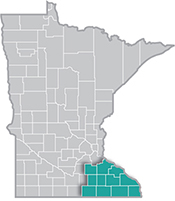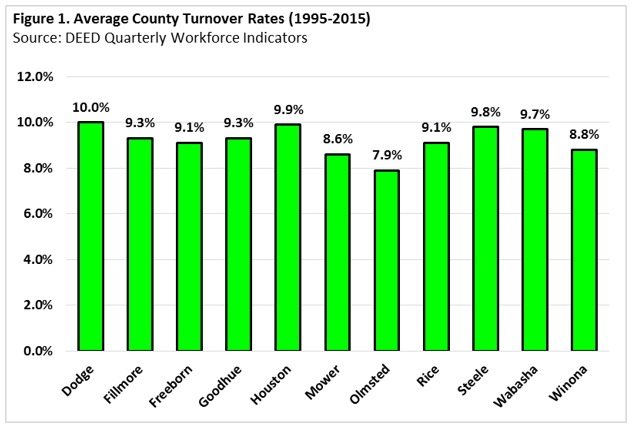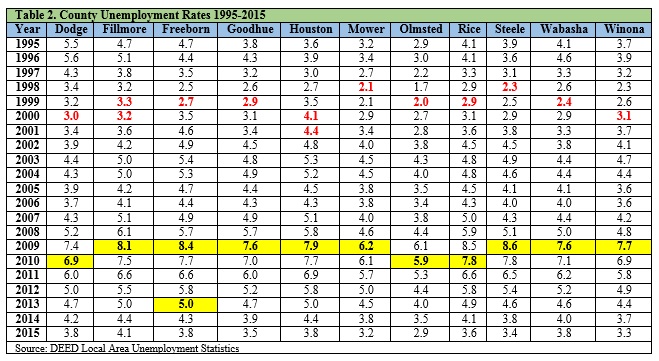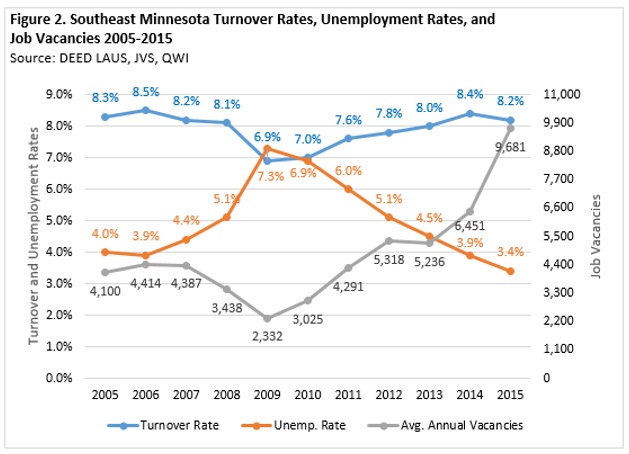 Southeast Minnesota is a health care and agricultural powerhouse. The region is home to the renowned Mayo Clinic and some of the world's most recognized food companies and brands.
Southeast Minnesota is a health care and agricultural powerhouse. The region is home to the renowned Mayo Clinic and some of the world's most recognized food companies and brands.
Advanced manufacturing is especially strong here, with machinery, chemicals, and electronics among the top products.
Want the freshest data delivered by email? Subscribe to our regional newsletters.
12/11/2017 9:47:04 AM
Employee turnover – the ratio of the number of employees who leave a company divided by the total employee count within the company – is a phrase unlikely to bring smiles to the faces of employers. Regardless of the reason for leaving, whether a voluntary separation or termination, the cost of employee turnover can be rather large.
For example, turnover impacts more than just costs associated with the hiring process, such as paying fees for a recruiter, costs to participate in and travel to job fairs, time spent by human resources and/or hiring authorities to sift through applications, decide who to interview, then conduct the interviews. Financial impacts also include post-interview costs (time spent conducting reference checks or pre-employment testing) and employment costs (hiring bonuses or expenses accrued to relocate the new employee).
The article Quantifying Average Employee Turnover "estimates that replacing the right employee can cost between 30% to 400% (average stands at 150%) of an employee's annual salary…" and refers to a study conducted by the Allied Workforce Mobility Survey in which one finding was that "about 30% of companies reported that it takes at least a year or more for new talent to leverage full productivity."
Additional post-hiring costs may include training the new employee, administrative costs of benefits and payroll enrollment and information technology staff time to set up new usernames, passwords and emails. According to the article Learn About the Cost of High Employee Turnover, opportunity costs and morale costs may present themselves during and after the hiring process. There may be a negative impact on the morale of other employees who have to pick up the slack left by an employee who may slow down their productivity prior to leaving and to fill the work void after they do leave. Also, there may be the costs associated with missed opportunities because efforts and resources were spent elsewhere during the hiring process.
The average turnover rate for the 11 counties in Southeast Minnesota from 1995-2015 was equal to or less than 10 percent, with Olmsted County enjoying the lowest average turnover rate of 7.9 percent and Dodge County seeing the highest right at 10 percent (Figure 1). According to What Your Employee Turnover Rate Says about Your Company, "a turnover rate of approximately 10% is considered normal and healthy", so it looks like employers in Southeast Minnesota are certainly meeting this threshold.

While the averages may be below this 10 percent threshold, this does not mean there was not any variation from year to year. On top of having the highest overall average, Dodge County also saw the highest range in turnover rates between 1995 and 2015, spanning from 6.9 percent to 13.9 percent. On the other hand, Fillmore County experienced the lowest range, peaking at 11.8 percent and bottoming out at 8.1 percent (Table 1).

What is interesting about this regional data is that there is a small window in which all of the highest and lowest turnover rates occurred. All 11 counties saw their highest turnover rates between 1998 and 2000, while the lowest turnover rates were within only a two-year period between 2009 and 2010. Further exploration shows a link between these time frames and the concurrent county unemployment rates. During the period in which the counties experienced high turnover they saw some of the lowest, if not the lowest, unemployment rates over the entire 20-year period (Table 2). Conversely, when the counties were suffering from high unemployment rates, there were much lower turnover rates.

This is likely more than just a coincidence. For example, during the recession years (2009-2010) where unemployment was much higher and the turnover rates in the Southeast region were at their lowest, the number of vacancies also bottomed out at an average of only 2,302 vacancies in 2009 and 3,025 in 2010.
This seems to be part of a general trend when comparing these three economic characteristics – as unemployment rates increase, both the number of job vacancies and turnover rates decrease, and vice versa (Figure 2).

When looking at percentages, note the net impact, in this case the actual number of people that have left a company, varies by the size of the company. For example, a small business that sees a 10 percent turnover rate and only employs 10 people would see a loss of one employee, whereas a large employer who has 2,000 employees would see a loss of 200 workers at a 10 percent turnover rate.
Contact Mark Schultz.